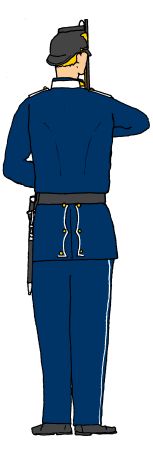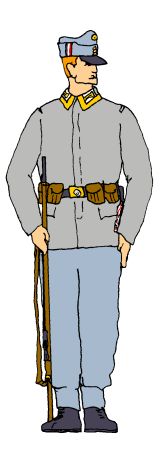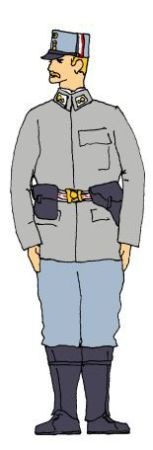|
|
Background to the Marine Detachment Skutari 1913-14
At the Treaty of London in 1913 ending the First Balkan War it was
agreed that Albania be recognised as an independent state. The city of
Skutari (modern Shkodër) was given an international peacekeeping force
mainly to defend it from the Montenegrins who had occupied it during the
recent war. The international force consisted of troops from Great
Britain, France, Austria-Hungary, Italy and Germany. The German
contribution was an 100 strong detachment from the I. and II.
Seebataillon, known as the Marine-Detachment Skutari commanded
firstly by Hauptmann von Klitzing and from September 1913 by Major Paul Schneider.
When the First World War broke out the
German troops were placed under Austro-Hungarian command and served as
the 5th Company of the IV Battalion the Austrian 87th Infantry Regt (who had also been part of the Skutari garrison). As such they saw action against the Serbians at
Višegrad, Bosnia on 20th August 1914. Several of the German marines
received Austro-Hungarian decorations for bravery in this action.
The
Marine Detachment Skutari was then withdrawn to Germany, where it was
disbanded on 7th September 1914
and used to form the cadre of the 10th Seebataillon of the
Marinekorps Flandern on the Western front.
Uniforms of the Marine Detachment
in Skutari
Officers and other ranks of the Marine
Detachment Skutari in peacetime wore the same
Dark Blue Winter Uniforms,
Grey Litewka Uniforms and
Khaki
Summer Uniforms as worn by most Marine
Infantry units. Their shoulder straps displayed no battalion numeral.
Likewise the headdress consisted of the Jäger-style shako or blue and
white field cap in winter or the 1900 Bortfeldt Tropical Helmet or khaki
field cap, both with neck-shades in the Summer months. They were also
issued mosquito nets. When on parade in Vienna on their return journey to
Germany, the unit were photographed all wearing their khaki uniforms
with tropical helmets. The unit had black leather equipment and the
Gew98 rifle as issued by their Seebataillon units in Germany.
In "Das Deutsche Heer, Friedensuniformen
bei Ausbruch des Weltkrieges " Knötel and Pietsch record that NCO
rank insignia was worn on the lower side of the collar of the khaki
uniform by the Marine
detachment Skutari. Most Marine Infantry wore this insignia on the top
edge although this practice has also been noted with some NCOs
previously in South West Africa.
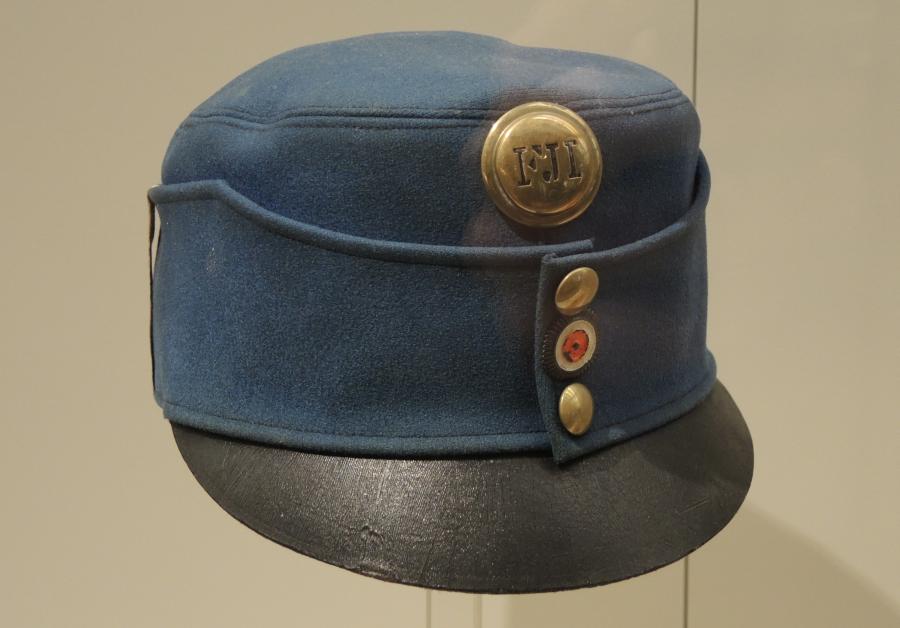
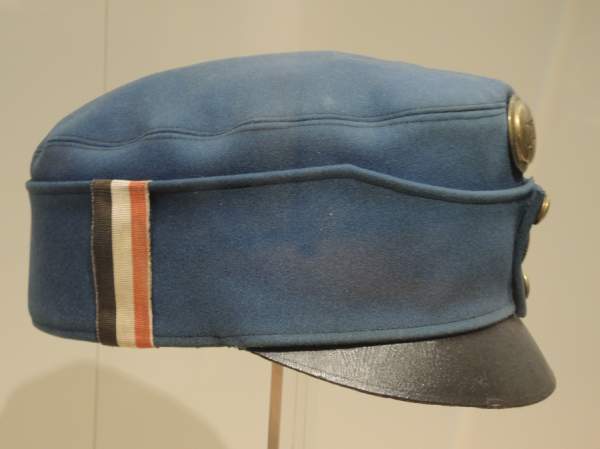
Austro-Hungarian Army Cap worn by the
Marine Detachment Skutari in 1914
This cap was owned by Seesoldat Rau, it is Austro-Hungarian army
issue with a brass badge for Kaiser Franz Josef but has the German
cockade at the front an a strip of red white black colours on the right
hand side.
Photo from
Internationales Maritimes Museum Hamburg
©
Mark Schellenberg 2016
Hybrid Austro-Hungarian Uniforms at Višegrad
The unit's commander Major Paul
Schneider reported in an official message (quoted in
"Die deutschen
Marinen 1818-1918" by Rolf Noeske and Claus
P. Stefanski) that the unit
were given partial Austro-Hungarian army uniforms to replace their
existing khaki uniforms. They also received Austro-Hungarian. This would
presumably been to prevent friendly fire incidents by making their
appearance similar to that of the Austro-Hungarian infantry (in
pike-grey with peaked caps) and to have standardised ammunition issue
among the two allied forces.
I have not found any period photos to
show the use of these hybrid uniforms. They are described by Noeske and
Stefanski, and in "Unsere Marineuniformen"
by J.Zienert. There is also an illustration by an unknown artist showing
the hybrid uniforms shown in Noeske and Stefanski's book "Die deutschen
Marinen 1818-1918".
Both officers and other ranks wore their
grey Litewka tunics with Austrian army trousers and Austrian
army officers shakos and other ranks caps.The German Litewka tunics had the
shoulder straps removed. The other ranks kept their white collar patches
with yellow Litzen and German NCO insignia, while the officers wore
white collar patches with one or two Austrian army rank stars at the
front, with the German Imperial crown behind.
The cap in the International Maritime
Museum in Hamburg is a light blue pre-war Austrian cap, rather than the
pike grey caps introduced to the Austrian army in 1908. On the Austrian army headgear, the
Germans wore the imperial cockade from their field caps in between the
two brass buttons on the front of the cap below the Hapsburg gold and
black cockade and a strip of vertical lace in the Imperial colours. It
is reported that this worn worn on the right side of the cap by other
ranks and on the left side of the shako by officers.
Other ranks were issued with Austrian
army Mannlicher rifles while the officers retained their German small
arms. German black leather boots and equipment were worn but with
Austrian brown leather Mannlicher ammunition pouches for other ranks.
The Mannlicher rifle had a sloped cartridge clip and this required
similarly sloped ammunition pouches. Belt buckles and sword and bayonet
knots were German.
After their action at the Battle of
Visegrad the unit returned to their German Marine Infantry khaki
uniforms for their return journey to Germany via Vienna.
| |
|
|
| |
The Illustrations
Figure 1 is based on a
photograph of a Seesoldat of the Marine Detachment Skutari
in Skutari 1913. He wears the standard Marine Infantry dark blue
peacetime unifirm with Jager style shako and black leather
equipment as worn at home in Germany.
Figure 2 shows an
Unteroffizier of the Marine Detachment Skutari as they are
reported to have appeared at the Battle of Višegrad in August
1914. It is one of the very few illustrations on this website
not based on a period photograph. Instead it is based on
descriptions and an illustration by an unknown period artist
(reprinted in "Die
deutschen Marinen 1818-1918" by
Rolf Noeske and Claus P. Stefanski). He wears a combination of
German and Austro-Hungarian uniform. The Litewka without
shoulder straps is German with German rank lace on the collar.
The cap and trousers are Austro-Hungarian army issue, the cap
having an extra German cockade between the buttons on the front
and a strip of ribbon in German colours on the right side. He
has German black leather boots and belt with belt buckle but
Austro-Hungarian ammunition pouches and Mannlicher rifle.
Figure 3 shows an
Oberleutnant of the Marine Detachment Skutari as they are
reported to have appeared at the Battle of Višegrad in August
1914. It is one of the very few illustrations on this website
not based on a period photograph. Instead it is based on
descriptions and an illustration by an unknown period artist
(reprinted in "Die
deutschen Marinen 1818-1918" by
Rolf Noeske and Claus P. Stefanski). He wears a combination of
German and Austro-Hungarian uniform. The Litewka without
shoulder straps is German with an Austrian rank on the collar
patch in front of the German imperial crown from the removed
German shoulder strap.
The shako and trousers are
Austro-Hungarian army issue, the cap having an extra German
cockade between the buttons on the front and a strip of ribbon
in German colours on the left side. He has German short black
leather boots and gaiters. His belt with belt buckle are
standard for German Marine Infantry officers. His pistol is also
German or privately purchased.
Figure 4
is based on a photograph of an Unteroffizier of the Marine Detachment
Skutari taken in Vienna in September 1914 on their return journey to
Germany after seeing action against the Serbs in the opening phase of
the First World War. He wears the khaki tropical uniform with the khaki
tropical helmet as was worn by the Marine Detachment during the Summer
months. Note the NCO lace (with several red and black threads
on a white background) on the lower edge of the collar and the cuffs.
Note also the newly awarded Austro-Hungarian silver medal of military
merit. Several of the detachment, including their commander Major Paul
Schneider, received awards for their service under Austro-Hungarian
command. |
|
| |
|
|
|
|
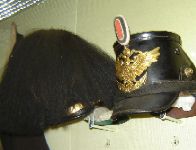
Two Seebataillon Shakos
The one on the left is completely
obscured by its parade plume
(See
Brussels Royal Army Museum Page)
Musée Royale de l'Armée Collection, Brussels, Belgium
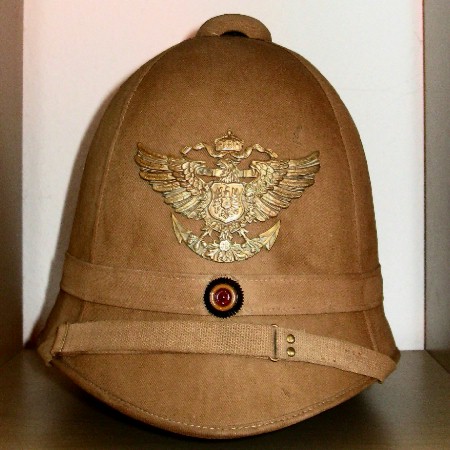
Seebataillon Bortfeldt 1900
Tropical Helmet
(See
Tropical Helmets Page)
Photo
©
Private Collector
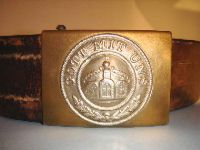
Naval Other Ranks Belt Buckle
(See
Belt Buckles Details Page)
Photo
© Doppler
Collection
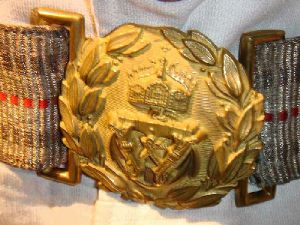
Naval Officers Belt Buckle
(See
Belt Buckles Details Page)
Photo
© Doppler
Collection
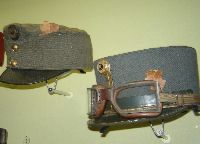
Austro-Hungarian Other Ranks
and Officers Caps
(See
Brussels Royal Army Museum Page)
Musée Royale de l'Armée Collection,
Brussels, Belgium
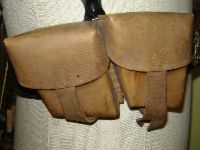
Austro-Hungarian Mannlicher Ammunition Pouches
(See
Brussels Royal Army Museum Page)
Musée Royale de l'Armée Collection,
Brussels, Belgium
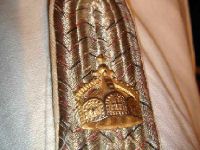
Seebataillon Officer's Shoulder Strap
The crown of the shoulder strap was
used on officer's collar patches at Višegrad
(See
Seebataillon White Uniform Page)
Photo
© Doppler
Collection |
|
|
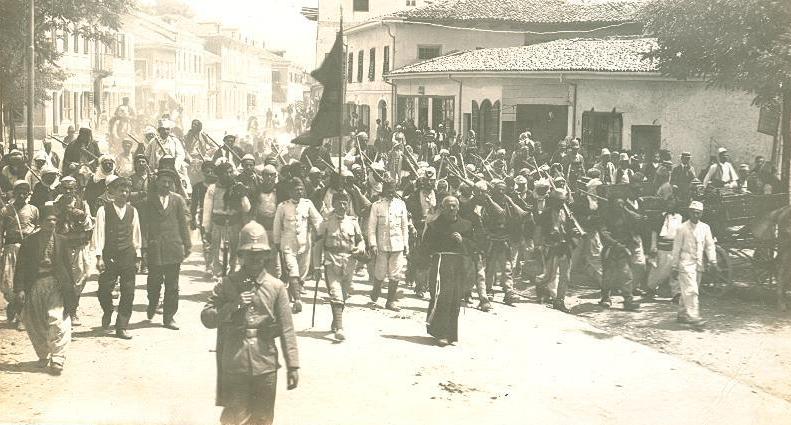
Street Scene in Skutari 1913/14
Note the German Marine in the foreground wearing a Bortfeldt
tropical helmet with an imperial eagle on the front.
Photo from
Kamri
| |
|
|
| |
Description of the
Marine Detachment Skutari from 'Bridge on the Drina' by Ivo
Andrić Bridge on
the Drina is a classic of Bosnian literature written by
Ivo Andrić, telling the story of various occupations and everyday
life in Bosnia over 350 years
through the eyes of those around the bridge on the River
Drina at Višegrad. Andrić makes
mention of the German Marine Detachment Skutari before their
action at Višegrad, He describes their tropical helmets but
says their uniforms were white. It is possible that the
officers wore white but the other ranks were not issued
white uniforms. Perhaps their khaki uniforms had been
bleached lighter by the sun.
"Not far from that municipal shed
a
detachment of an unusual army was resting. The men were
in white uniforms with white tropical helmets on their
heads. They were Germans, the so-called Skadar
detachment. Before the war they had been sent to Skadar
(Skutari in Albania) where they were to maintain law and
order together with detachments from other nations, as part
of an international army. When war broke out they had
received orders leave Skadar and place themselves at the
disposal of the nearest Austrian army command on the Serbian
frontier. They had come the evening before and were now
resting in the hollow which separated the square from the
market place. There in a sheltered corner they awaited the
order to attack. There were around 120 of them.
Their
captain a plump reddish man who suffered from the heat, had
just been cursing at the Gendarmerie sergeant Danilo Repac,
cursing him as only a senior officer of the German Army can
curse, noisily, pedantically and without any sort of
consideration. The captain was complaining that his soldiers
were dying of thirst, that they had not even the most basic
supplies, since all the shops were shut nearby, which were
probably full of everything, were shut despite the order
that all shops were to remain open.
"What
are you here for? Are you Gendarmes or dolls? Must I die
here with all my men? Or must I break open the shops like a
robber? Find the owners at once and make them sell us
provisions and something worth drinking! At once, do you
understand what that means? At once!"
And
with every word the captain grew more and more flushed. In
his white uniform, his close shaven head red as a poppy, he
seemed to burn with anger like a torch."
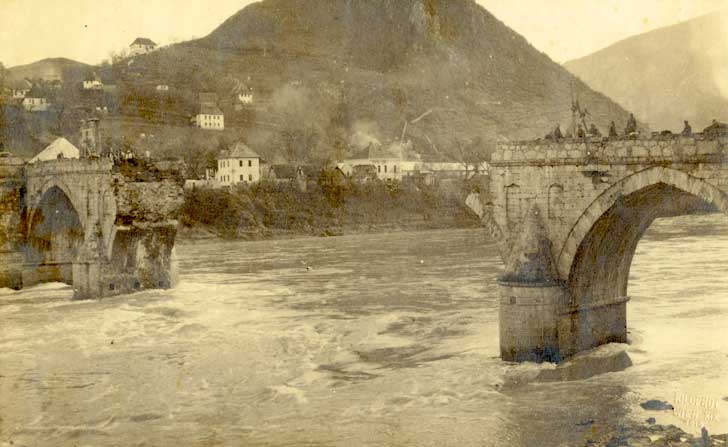
The Damaged Bridge over the Drina at
Višegrad 1915
Photo on
WikiCommons |
|
| |
|
|
Sources
"Unsere Marineuniformen"
by J.Zienert, (H.G.Schulz, Hamburg 1970)
"Die deutschen Marinen 1818-1918: Organisation, Uniformierung,
Bewaffnung und Ausrüstung"
by Rolf Noeske and Claus P. Stefanski
(Verlag Militaria,
Vienna)
"Tropenhelme der
kaiserliche Marine, der Ostasiatischen Truppen und der Schutztruppen"
by Ulrich Schiers (Deutsche
Gesellschaft für Heereskunde)
"Das Deutsche Heer,
Friedensuniformen bei Ausbruch des Weltkrieges
"
H Knötel and P Pietsch (Diepenbroick-Grüter & Schulz 1935)
Marine Infanterie -
Article on the Marine Detachment Skutari.
The
Austro-Hungarian Army - Article on Austro-Hungarian awards to members of
the Detachment.
The Military Participation of the Austro-Hungarian Monarchy in the
Skutari Crisis by Tobor Balla - Article on Austro-Hungarian
and German military in Skutari
Axis History Forum discussion on the Marine Detachment Skutari
- Glenn Jewison's post in this thread gives more details the Marine
Detachment Skutari:
"In 1913 the city of Skutari received an international occupation
force initially under the command of the British Admiral Sir Cecil
Burney and later under Colonel Philips.
The force consisted of:
1 Austro-Hungarian Battalion: IV./I.R. 87
1 Italian Battalion
1 British Battalion: West Yorkshire Regiment
2 French Companies: 24th Colonial Regiment
1 German Company
The German company was formed by the All Highest Cabinet Order of 28
June 1913 from personnel of the I. and II. Seebataillone as the
"Marine-Infanterie-Detachement" and embarked from Trieste on the 2nd
July 1913 on S.M.S. Breslau, transferred to an Italian river gun
boat on the 6th and landed at Skutari on the 7th of July 1913.
The strength of the company was:
1 Field Officer as chargé d'affaires - Major Paul Schneider
1 Hauptmann/Oberleutnant as company commander
2 Company Officers
1 Naval Medical Officer - Marine-Stabsarzt
1 Naval Paymaster - Marine-Zahlmeister
1 Feldwebel
11 Unteroffiziere
97 Seesoldaten
With the outbreak of war the company participated in the securing of
the Drina sector between 16 and 19 August 1914 as the 5th company of
the Austro-Hungarian battalion and at the encounter at Višegrad on
the 20th where they lost three men KIA. A further 2 officers and 21
Seesoldaten were wounded. At the time they were under command of the
1st Infantry Division , XV Corps. After transiting through Sarajevo
they returned to Germany via Vienna (3rd to 5th September) The
company was disbanded on the 7th of September 1914."
It should be noted that this is a
very casualty rate for such a small unit- 50% of officers and 20% of
other ranks. The Germans apparently requested of their Austrian
command that they be in the frontline of the action.
Thanks to Glenn Jewison,
Tatjana Bonny and
Mark Schellenberg for providing
information on this unit and the action at Višegrad. |
